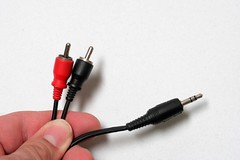The Plumbing of Social Marketing
by Holland-Mark | September 29, 2009

- Image by Mac Users Guide via Flickr
When I hit “publish” on this blog post, busy elves will make good things happen all across the interwebs. The post will hit this WordPress blog first, then, via RSS, reach our followers on FriendFeed. Other content – from our agency and personal Flickr, YouTube, and Twitter accounts – will do the same, and a comprehensive feed of all things Holland-Mark will be created there. A subset of that content will be posted to Twitter, including this post, drawing more people to the site. Some of these folks will hit the Tweetmeme button embedded in the lower right of this site, drawing still more people in. Related posts on other sites will be linked to at the bottom of this post, with just a click or two using the Zemanta plug-in, and links back to this post will appear on those blogs.
A subset of all this content – just the “official” agency stuff – will hit our Tumblr account, creating a more focused, agency RSS feed. That will drive Notes in our facebook fan page, which will appear in the news feeds of the 120 or so people who already follow us on facebook, and be seen by everyone who follows them. And the cycle will continue.
Wassat? No elves on your payroll? Well… good news… you can achieve the same result by getting the plumbing right across your social site profiles. Doing so is one of the more critical aspects of building a social media presence on the back of content worthy of attention, though it’s all too rarely talked about among the digerati*.
As unsexy as the plumbing stuff is… If you get the Gospel of Good Content at the core of your social media effort, you’re working hard to put good stuff out there. Why would you not do everything you can to see that it gets the maximum possible distribution? If the answer is “because this is all too freaking complicated, wiseguy,” read on.
The Key Concepts
Let’s start with a few key concepts:
- Content is the core of your social marketing strategy. Not Twitter. Not facebook. Not blogging. CONTENT, in whatever form, but always at the intersection of what your target users are looking for online, and what you are uniquely able to provide.
- Social marketing success is a marathon, not a sprint. A sustained effort is necessary to get the business result, which means your strategy to create and leverage content must live within the constraints of the resources you’re able to commit to it over the long haul.
- The absolute key to getting the maximum impact from the minimum necessary content development investment is to connect your disparate social networking presences in such a way that creates a whole greater than the sum of its parts.
Still too complicated? How about this: Whatever you publish in one place should appear, automatically, everywhere else. While it’s obvious how this serves your interests, remember it serves your audience’s as well. This approach makes your content available to people in the places they want to consume it, and it creates feeds that let them subscribe to just the content types they’re interested in.
Feeders, Endpoints & Aggregators
The key to making this work is to distinguish among three social network account types:
- Feeders – Which are places you post content. You’ll need one of these for every content type you post… examples include a Blog for long-form text, Twitter for snippets, Google Shared Items for links, Flickr for images, YouTube for video, etc. etc. You can have as many of these as you like, though I’d recommend limiting yourself to one per content type just to keep things simple.
- Endpoints – Which are places you want your content to end up. Wherever your target user hangs out, you should maintain an endpoint. If it’s facebook, make a fan page. If it’s Tumblr, be there. If it’s some Ning site, same deal. With endpoints it’s pretty much the more the merrier, so long as the content you’re sending out is of some value to the community built around that endpoint.
- Aggregators – Which are hubs that make it easy to get content in from your Feeders and out to your Endpoints. I like FriendFeed for this, but I’ve seen people use Posterous, Ping.fm, and even Google Reader to handle this function.
After you get your accounts set up, you just connect the respective inputs and outputs like you did on your home entertainment system:
- Connect the outbound RSS from every Feeder to your primary Aggregator.
- Consider setting up a secondary or even tertiary Aggregator to provide partial feeds to those only interested in a specific subset of content.
- Connect the outbound RSS from one or another of your Aggregators to all of your Endpoints.
There may be some RSS trickery necessary to make this happen, and to start you’ll almost definitely make a mistake that creates duplicate entries one place or another. Don’t sweat it, just be systematic in rooting out problems, and getting the system up and running. Keep at it, and sooner than you might think, you’ll have the whole thing spinning like a top, getting the good stuff out to the people interested in it.
- An excellent post by Louis Gray on how to get the most out of your Google Reader shared items.
- Here’s another one from Louis a while back, on the value of pulling your blog into FriendFeed. (Louis Gray is on the list of must-subscribe folks, IMHO, and there’s a lot of other great stuff on his blog.)
- Chris Brogan’s classic “50 Steps” post lays out a linking strategy one breadcrumb at a time.
- Michael Calienes calls this ‘Presence Engineering,’ and has posted a lot on the subject (hat tip to Edward Boches for uncovering this one).
- Sure there’s more; please add anything good you’ve come across in the comments.
Related articles by Zemanta
- More on Google Reader as the killer social app. (socialfish.org)
- How to Blog. A Lot. (newcommbiz.com)
- Social Media 101: A Taste of the Tools that are Changing the World (slideshare.net)
- The Power of Conversation – Developing a Social Media Strategy That Works (slideshare.net)

![Reblog this post [with Zemanta]](http://img.zemanta.com/reblog_e.png?x-id=8de3b401-c3c3-4b10-bb91-9270038b5538)